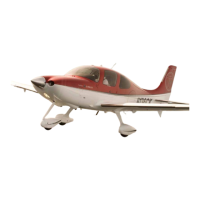Cirrus Design Section 10
SR22T Safety Information
P/N 13772-003 10-7
Landing Considerations
After a CAPS deployment, the airplane will descend at less than 1700
feet per minute with a lateral speed equal to the velocity of the surface
wind. The CAPS landing touchdown is equivalent to ground impact
from a height of approximately 13 feet. While the airframe, seats, and
landing gear are designed to accommodate the stress, occupants
must be prepared for the landing. The overriding consideration in all
CAPS deployed landings is to prepare the occupants for the
touchdown in order to protect them from injury as much as possible.
Emergency Landing Body Position
The most important consideration for a touchdown with CAPS
deployed is to protect the occupants from injury, especially back injury.
Contacting the ground with the back offset attempting to open a door
or secure items increases the likelihood of back injury. All occupants
must be in the emergency landing body position well before
touchdown. After touchdown, all occupants should maintain the
emergency landing body position until the airplane comes to a
complete stop.
The emergency landing body position is assumed with tightened seat
belt and shoulder harness by placing both hands on the lap, clasping
one wrist with the opposite hand, and holding the upper torso erect
and against the seat backs. The seat cushions contain an aluminum
honeycomb core designed to crush under impact to absorb downward
loads and help protect the spine from compression injury.
Door Position
For most situations, it is best to leave the doors latched and use the
time available to transmit emergency calls, shut down systems, and
get into the Emergency Landing Body Position well before impact. The
discussion below gives some specific recommendations, however, the
pilot's decision will depend upon all factors, including time to impact,
altitude, terrain, winds, condition of airplane, etc.
There is the possibility that one or both doors could jam at impact. If
this occurs, to exit the airplane, the occupants will have to force open a
partially jammed door or break through a door window using the
Emergency Exit Hammer located in the lid of the center armrest. This
can significantly delay the occupants from exiting the airplane.
If the pilot elects to touchdown with a door opened, there are several
additional factors the pilot must consider: loss of door, possibility of
head injury, or injury from an object coming through the open door.
Original Issue

